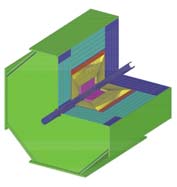The Detector
The e+e-; annihilation experiments in this energy region have a remarkable advantage. Thanks to its clean experimental conditions, all the fundamental particles such as W, Z, top, and Higgs can be reconstructed through quark-jet invariant mass method.
A high resolution hadron calorimeter is the key for achieving the best energy-flow measurements. Together with a high resolution tracker, it then assures the best quark-jet invariant mass resolution, thereby allowing us to fully exploit this novel feature of the experiments.
Since the most important physics target is the Higgs boson, the detector should be capable of measuring nature of Higgs boson in detail. In the Higgs production process e+e-» Zh followed by a Z » l+l- decay, the Higgs boson mass and Higgs boson width can be determined by measuring the mass recoiling against the Z boson. There is a limitation in the recoil mass resolution, which is determined by the width of the initial beam energy. Hence, we require that the recoil mass resolution should be comparable with the width of the JLC beam energy, 0.1% in our central tracker design. For detailed studies of the Higgs boson, it is essential to have good flavor-tagging efficiencies for both bottom and charm quarks. We thus need a high precision vertex detector. Taking into account these requirements and possible future upgrading, we are now considering a large general-purpose detector. A large 3 Tesla superconducting solenoid magnet is placed outside of the calorimeter in order to keep the hermeticity for the calorimeter system.
 |
3 Tesla Detector Model
|
The energy resolutions of the calorimeter consisting of lead-scintillator layers with readout fibers are 15% for 1 GeV electrons/photons and 40% for 1 GeV hadrons. We adopt a small-cell jet chamber as the central tracker to achieve spatial resolutions of 100 µm in r-∅ and 1 mm in z directions, and a two-track resolution of better than 2 mm. At the center of the detector very close to the interaction point, there is a CCD vertex detector, whose innermost radius is 2.5 cm from the beam line. The spatial resolution of the vertex detector is expected to be better than 4 µm. The proof-of-principle phase of the R&D's for these detector components is almost completed and we are now moving towards the detector design in engineering aspect.
